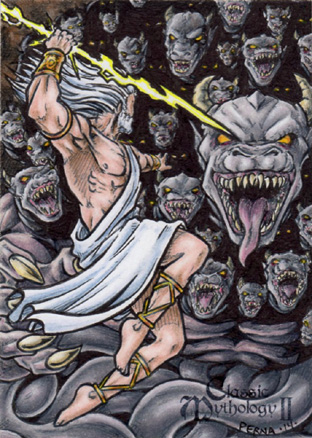Deviation Actions
Description
Perna Studios is very excited to announce our third trading card set entitled Classic Mythology II. This set will focus on 5 timeless Classic Mythologies that we have all come to love and enjoy during our lifetime. The mythologies spotlighted in this set are Greek, Norse, Egyptian, Celtic and Native American. We have an impressive list of artists involved on this set working on both base/promo cards and sketch cards. Set scheduled to be released in early Spring 2014.
This art of Zeus Vs. Typhon from Greek Mythology will be a sketch card inserted in our Classic Mythology II card set. Card set will be released in April 2014.
Zeus – Greek Mythology – Zeus was the "Father of Gods and men" who ruled the Olympians of Mount Olympus as a father ruled the family. He was the God of the Sky, Thunder and Lightning in Greek mythology. Zeus was the child of Cronus and Rhea, and the youngest of his siblings. Zeus was married to his sister Hera and known for his erotic escapades. These resulted in many godly and heroic offspring, including Athena, Apollo and Artemis, Hermes, Persephone (by Demeter), Dionysus, Perseus, Heracles, Helen of Troy, Minos, and the Muses (by Mnemosyne); by Hera, he is usually said to have fathered Ares, Hebe and Hephaestus. Some of Zeus’s symbols include the thunderbolt, eagle, bull, and oak. Zeus is frequently depicted by Greek artists in one of two poses: standing, striding forward, with a thunderbolt leveled in his raised right hand, or seated in majesty.
Typhon – Greek Mythology - (also Typhoeus, Typhaon or Typhos) was the last son of Gaia, fathered by Tartarus, and the most deadly monster of Greek mythology. He was known as the "Father of all monsters"; his wife Echidna was likewise the "Mother of All Monsters." Typhon was described in pseudo-Apollodorus, Bibliotheke, is the largest and most fearsome of all creatures. His human upper half reached as high as the stars. His hands reached east and west and, instead of a human head, he had a hundred dragon heads; some however depict him as having a human head and the dragon heads being attached to his hands instead of fingers. He was feared even by the mighty gods. His bottom half was gigantic viper coils that could reach the top of his head when stretched out and made a hissing noise. His whole body was covered in wings, and fire flashed from his eyes. Typhon attempts to destroy Zeus at the will of Gaia, because Zeus had imprisoned the Titans. Typhon initially overcame Zeus in their first battle, and tore out Zeus' sinews. However, Hermes recovered the sinews and restored them to Zeus. Typhon was finally defeated by Zeus, who trapped him underneath Mount Etna.
Typhon fathered several children by his niece, Echidna, daughter of Phorcys and Ceto:
Orthrus, a fearsome two-headed hound. Orthrus, and his master, Eurytion, son of Ares and the Hesperid Erytheia, guarded the fabulous red cattle of Geryon. Both were slain, along with Geryon, when Heracles stole the red cattle.
The Sphinx was sent by Hera to plague the city of Thebes. She was the most brilliant of Typhon's children, and would slay anyone who could not answer her riddles (possibly by strangling them). When Oedipus finally answered her riddle, she threw herself into the ocean in a fit of fury and drowned.
The Nemean Lion was a gigantic lion with impenetrable skin. Selene, the moon goddess, adored the beast. Heracles was commanded to slay the Lion as the first of his Twelve Labors. First, he attempted to shoot arrows at it, then he used his great club, and was eventually forced to strangle the beast. He would then use the Lion's own claws to skin it, whereupon he wore its invulnerable hide as armor.
Cerberus, another one of Typhon's sons was a three-headed dog that was employed by Hades as the guardian of the passage way to and from the Underworld. According to Hesiod, he was the son of Orthrus and Echidna.
Ladon was a serpentine dragon, known as a drakon. According to Hesiod, Ladon was the son of Phorcys and Ceto, instead of Typhon and Echidna. Regardless of his parentage, Ladon entwined himself around the tree in the Garden of the Hesperides at the behest of Hera, who appointed him the garden's guardian. He was eventually killed by Heracles.
The Lernaean Hydra, another one of Typhon's daughters, terrorized a spring at the lake of Lerna, near Argos, slaying anyone and anything that approached her lair with her noxious venom, save for a monstrous crab that was her companion. She was originally thought to have nine heads, and any neck, if severed,would give rise to two more heads, her ninth head was immortal. She and her crab were slain by Heracles as the second of his Twelve Labors - he cut off her heads and burnt the neck so that she could not regenerate,and crushed her ninth head under a rock, (the crab being accidentally crushed underneath Heracles' heel).
Typhon's last child was his daughter, Chimera. Chimera resembled a tremendous, fire-breathing lioness with a goat's head emerging from the middle of her back, and had a snake for a tail. She roamed the ancient kingdom of Lycia, particularly around Mount Chimaera (possibly near Yanartaş), bringing bad omens and destruction in her wake, until she was slain by Bellerophon and Pegasus at the behest of Iobates.






























